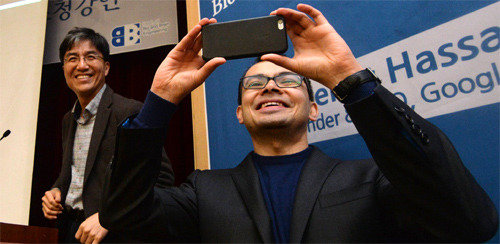AlphaGo developer gives a lecture at KAIST
AlphaGo developer gives a lecture at KAIST
Posted March. 12, 2016 07:06,
Updated March. 12, 2016 07:11

Hassabis continued, "There is nothing to be afraid of in regards to the rapid development of AI. AlphaGo's system has only one function (playing go)." When asked if AlphaGo starts a dystopia triggered by AI, he answered, "Developing AI with that level of intelligence will take a very long time. That cannot happen now." Then he gave an example of AI usage noting, "Sorting spam mails in your mail box is also AI's job."
AlphaGo had two matches with Lee Se-dol (level 9) and won by a wide margin. To the comment, "AlphaGo seems to make mistakes intentionally but it in the end it always wins," Hassabis answered, "I cannot give a detailed explanation about that because AlphaGo learned the skill by itself through Deep Learning. AlphaGo was designed to prioritize important points." He added, "When AlphaGo was having a match with Fan Hui (level 2), the European champion, what was seen as a complete mistake of AlphaGo turned out to outmaneuver its opponent. I was really surprised."
When Hassabis said, "I wish Lee good luck for the next match with AlphaGo," the audience laughed. Then he said, "I mean it."
Hassabis introduced AI game strategy for games made by DeepMind such as Breakout and Space Invader and explained, "We applied the 'Deep Learning' method to make the computer figure out how to master the games. The result was not good in the first trial, but after hundreds of practices, it became better than human players." He added, "AlphaGo has the same number of operators as the previous program, but it is much improved through more learning."
The reason Hassabis came to KAIST despite his tight schedule in Korea is because of his connection with professor Lee Sang-wan of the Department of Bio and Brain Engineering at KAIST. Hassabis and Lee once shared the same lab when they were post-doctoral researchers at MIT. When Lee asked Hassabis to give a presentation to students, Hassabis gladly agreed.
Students and professors occupied all 200 seats and even corridors at the Dream Hall, the site of a Hassabis lecture. Those who could not make it into the venue still listened to the presentation outside. "The hall was designed to accommodate 200 people, but now there seems to be more than 500 people," a KAIST official said,
대전=전승민 동아사이언스기자enhanced@donga.com







